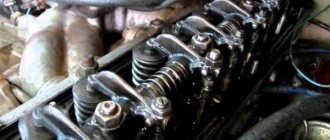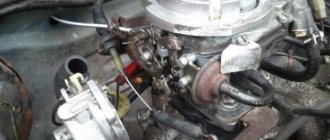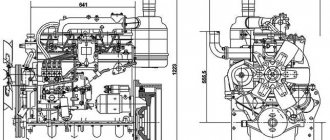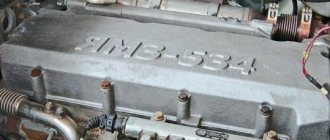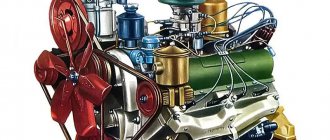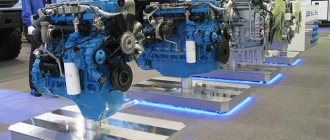Nowadays, popular and widespread commercial vehicles of the GAZ brand are equipped with UMZ engines produced at the Ulyanovsk Motor Plant. The Ulyanovsk Motor Plant dates back to 1944, and only in 1969 the company produced the first UMZ brand engine. Until 1969, the plant was engaged in the production of small-displacement engines UMZ-451 and their components.
Since the release of the first engine, they have faithfully served on trucks, off-road vehicles, and small buses. In 1997, AvtoGAZ became the main consumer of engines, which equipped most models of the GAZelle line with UMZ units.
Site about SUVs UAZ, GAZ, SUV, CUV, crossovers, all-terrain vehicles
The UMZ-4216 engine is intended for use in cars and trucks using a three-component catalytic converter in the exhaust system and ensures that the vehicle complies with Euro-3 toxicity standards corresponding to UNECE Rules No. 83-05.
UMZ-4216 engine, characteristics, data for adjustments and control, features of starting, stopping and running in the UMZ-4216 engine.
The UMZ-4216 engine contains a device for injecting gasoline into the intake channels (fuel pipe and injectors), a customized exhaust system, as well as sensors and actuators for working in an adaptive fuel supply and ignition control system with feedback via an oxygen sensor (in the exhaust system) and a sensor detonation (on the cylinder head).
The engine configuration 4216.1000400 is a gasoline engine with an integrated microprocessor control system for fuel injection and ignition; in the configuration 4216.1000400-20 there is an additional power steering pump.
Engine UMZ-4216, appearance on the left, front and right.
Technical characteristics of the UMZ-4216 engine.
Engine type - 4-stroke petrol with microprocessor controlled fuel supply and ignition. The number of cylinders is four. The order of operation of the cylinders is 1– 2 – 4 – 3. Cylinder diameter, mm – 100 Piston stroke, mm – 92 Displacement, l – 2.89 Compression ratio – 8.8
Rated power, kW (hp) at a crankshaft speed of 4000 rpm: gross - 90.4 (123) net - 78.7 (107) Maximum torque, Nm (kgcm) at a crankshaft speed of 2200- 2500 rpm: gross - 235.4 (24) net - 220.7 (22.5) Idle speed, rpm: minimum - 800+-50 maximum - 4500 Minimum specific fuel consumption according to external speed characteristic (gross configuration), no more, g/kWh (g/hp/h) — 269.3 (198) Oil consumption for waste as a % of fuel consumption (after vehicle mileage of 5000 km), not more - 0.2
The fuel supply system is distributed phased injection. The cooling system is liquid, closed, with forced circulation. Cooling system capacity without cooling radiator capacity, l - 3.5 Lubrication system - combined, under pressure and splash. Oil system capacity, without oil cooler capacity, l - 5.8
Electrical equipment is single-wire, the negative leads of the products are connected to the car body. The nominal voltage of the battery is 12 Volts. Generator - 9402.3701-17, 33.3771010, 4216.3708000-01 Starter - 422.3708000, 5732.3708000 Ignition system - microprocessor ignition control system with detonation feedback.
Clutch - single disc, dry. Weight of the engine unfilled with lubricant, kg - 172
Data for adjustments and monitoring the condition of the UMZ-4216 engine.
Gap between rocker arms and valves on a cold engine at 15-20 degrees, mm: - for exhaust valves of cylinders 1 and 4: 0.3-0.35 - for other valves: 0.35-0.4 Belt deflection when pressed with a force of 40N (4 kgf), mm: - between the fan and tension roller pulleys: 8-10 - between the generator and water pump pulleys: 7-9 - between the crankshaft pulleys and power steering pump: 12-17 Oil pressure (for control, no adjustment subject) at oil temperature plus 80 degrees, kPa (kgf/cm2): with the oil cooler turned off: - at 700 rpm: 125 (1.3)* - at 2000 rpm: 340 (3.5)* at oil cooler on: - at 700 rpm: 78 (0.8)* - at 2000 rpm: 245 (2.5)*
Minimum crankshaft rotation speed in idle mode, rpm: 800+-50 Gap between spark plug electrodes, mm: 0.7-0.8 Coolant temperature should be within the range, degrees: from plus 80 to plus 95 Installation ignition timing angle (in degrees of crankshaft rotation): 5 Oil consumption for waste, as a percentage of fuel consumption: 0.2*
* — Values of indicators for the warranty period of engine operation.
Features of starting and stopping the UMZ-4216 engine.
Before starting the UMZ-4216 engine with an unfilled power system, it is recommended to bleed air through a special fine fuel filter screw to speed up pumping of the fuel supply system. Starting and operating the UMZ-4216 engine. with the diagnostic warning light on, it can lead to failure of the converter and the oxygen concentration sensor. When starting the engine, do not press the throttle pedal.
After starting the engine, the engine control system will automatically set the required engine speed to warm up the engine and will gradually, as the engine warms up, reduce it to the minimum. If the UMZ-4216 engine does not start after 3 attempts, press the throttle pedal all the way and turn on the starter for 2-3 seconds. In this case, the control unit will perform the “Engine cylinder purge mode” function, and then try to start again. Before stopping the engine, it is necessary to let it run for 1-2 minutes at low crankshaft speed, then turn off the ignition.
Features of running in the UMZ-4216 engine.
Long-lasting and trouble-free operation of the UMZ-4216 engine largely depends on the running-in of parts during the initial period of operation. Observe the following instructions during the running-in period:
— The crankshaft rotation speed should be no more than 3000 rpm. — Avoid overloading the engine, do not allow high speeds and maximum vehicle load. — Monitor the coolant temperature. Avoid operating the engine at coolant temperatures close to the maximum limit.
Source
Adjusting valves UMZ 4216 with hydraulic compensators
The procedure for adjusting valves with hydraulic compensators installed on rods is carried out according to the same scheme as without compensators.
At the zero position of the crankshaft, the positions of the first, second, fourth and sixth plungers are adjusted using an adjusting bolt. By rotating 360 degrees (second rotation) the eighth, seventh, fifth and third are adjusted. The peculiarity of regulating the 42164 engine installed on the Gazelle business class Euro 4 is that there is no need to use test probes. The main tools for performing this procedure are open-end wrenches “14” and “11” and a slotted screwdriver.
Using a wrench set to “14” (a wrench set to “15” is rarely used), loosen the fixing nut on the adjusting bolt and unscrew the bolt until the rod with the compensator is completely relaxed. Then use a screwdriver to tighten the bolt until it comes into contact with the hydraulic compensator.
Next, using a wrench set to “11”, we continue to turn the adjusting bolt clockwise. Despite the recommendation of the bolt for two full turns, practice shows a different technique in which the compensator plunger takes the correct working position, namely:
- per one revolution, in case of adjusting the exhaust valve;
- one and a half turns on the intake valves.
The concept of “adjusting the valves” does not correspond to the actual procedures for adjusting hydraulic compensators on a Gazelle business car. After adjusting the position of the hydraulic compensators with a feeler gauge, you can check the gaps and make sure that the rocker arm pusher fits snugly against the end surface of the closed valve stem. The minimum permissible gap can be from 0.01 to 0.08 mm.
It is not difficult to adjust hydraulic compensators on internal combustion engines with your own hands. Instructions, wrenches, pliers and a screwdriver are all you need to perform maintenance on the gas distribution mechanism.
Sometimes, after operations, valves knock on a cold engine. The knocking of valves sometimes resembles the sound of an injector (nozzle) or an adsorber valve. Therefore, it is necessary to more accurately determine the source of the noise and it is better to do this with a stethoscope.
If knocking of valves with installed compensators is detected, it is necessary to warm up the engine to operating temperature and then increase the speed to 2000-3000. If the knocking does not stop, replace the hydraulic compensators.
Site about off-road vehicles, SUVs, off-road vehicles
The UMZ-4216 engine is intended for use in cars and trucks using a three-component catalytic converter in the exhaust system and ensures that the vehicle complies with Euro-3 toxicity standards corresponding to UNECE Rules No. 83-05.
UMZ-4216 engine, characteristics, data for adjustments and control, features of starting, stopping and running in the UMZ-4216 engine.
The UMZ-4216 engine contains a device for injecting gasoline into the intake channels (fuel pipe and injectors), a customized exhaust system, as well as sensors and actuators for working in an adaptive fuel supply and ignition control system with feedback via an oxygen sensor (in the exhaust system) and a sensor detonation (on the cylinder head).
The engine configuration 4216.1000400 is a gasoline engine with an integrated microprocessor control system for fuel injection and ignition; in the configuration 4216.1000400-20 there is an additional power steering pump.
Engine UMZ-4216, appearance on the left, front and right.
Technical characteristics of the UMZ-4216 engine.
Engine type - 4-stroke petrol with microprocessor controlled fuel supply and ignition. The number of cylinders is four. The order of operation of the cylinders is 1– 2 – 4 – 3. Cylinder diameter, mm – 100 Piston stroke, mm – 92 Displacement, l – 2.89 Compression ratio – 8.8
Rated power, kW (hp) at a crankshaft speed of 4000 rpm: gross - 90.4 (123) net - 78.7 (107) Maximum torque, Nm (kgcm) at a crankshaft speed of 2200- 2500 rpm: gross - 235.4 (24) net - 220.7 (22.5) Idle speed, rpm: minimum - 800+-50 maximum - 4500 Minimum specific fuel consumption according to external speed characteristic (gross configuration), no more, g/kWh (g/hp/h) — 269.3 (198) Oil consumption for waste as a % of fuel consumption (after vehicle mileage of 5000 km), not more - 0.2
The fuel supply system is distributed phased injection. The cooling system is liquid, closed, with forced circulation. Cooling system capacity without cooling radiator capacity, l - 3.5 Lubrication system - combined, under pressure and splash. Oil system capacity, without oil cooler capacity, l - 5.8
Engine design features
At the moment, there is a wide range of internal combustion engines from the UMZ model range, which are installed on different models of Sobol, UAZ, GAZelle cars. The installed engines have a number of common features, but may differ in some details and operating principles: ✔ Carburetor and injection. ✔ Four-cylinder in-line. ✔ Power 89-120 l. With. ✔ Environmental standards “Euro-0”, “Euro-3”, “Euro-4”. All engines are lightweight, small-sized and reliable. They are distinguished by their affordable prices. One of the features of the engine is the original design of the cylinder block, cast from aluminum, with pressed liners made of gray cast iron. During manufacturing, crankshafts of motors of all modifications undergo hardening of the main and connecting rod journals with high-frequency currents. A self-clamping rubber seal seals the rear of the crankshaft.
InjectorService.com.ua
Car diagnostics using USB Autoscope
GAZelle ZMZ-405 - ignition timing
GAZelle ZMZ-405 - ignition timing
Post by vadim78 » Jul 26, 2022, 04:53 pm
Re: Ignition timing
Post by Slavgaz » July 26, 2022, 5:51 pm
Re: Ignition timing
Post by savus » Jul 26, 2022, 6:27 pm
Re: Ignition timing
Post by vadim78 » Jul 26, 2022, 8:32 pm
In general the situation is like this. I got a job in a park where the cars are exclusively Gazelle 2006-2008. Previously, he worked as an auto electrician where TS were Kamaz and MAZ. And here it is like this. You open the hood and it’s amazing to see that instead of the RDV there is a faucet and I can’t imagine what to do with it, the TPS, DPRV sensors, the forces are torn off. The car has an LPG. So I bought a scanner, but there are more questions than answers, but oh well. The Gazelle I was working with today works kind of stupidly when you open the throttle, a failure occurs, you can sneeze into the intake. Doesn't accelerate while driving. In general, the matter ended with the fact that a mechanic came and brought an ECU from a carb Gazelle and said let him install it and drive. They started it up and it's running. According to the scanner, the angle was somewhere around 20-25 degrees. The mechanic drove T.S onto the line. So I’ll probably meet the car at MOT or earlier. There are a lot of such junk cars here. The work day is over but I’m not in the mood. What should I do with them now?
ECU diagnostics
In order to understand which of the sensors or components affected the unstable operation of the engine, it is worth conducting a comprehensive diagnosis of the on-board computer. This requires an OBD II cable, a tablet and laptop, and software.
It is recommended to turn to professionals for help, who will quickly and efficiently perform diagnostic operations and fix the problem.
Deciphering error codes
If the car owner nevertheless decides to fix the problem on his own, then he will need to decipher the error codes that will appear on the diagnostic computer screen. So, let's look at all the error codes and their interpretation for the UMZ 4216 engine:
| P0221 | Range limit of the difference between 1 and 2 tracks of TPS |
| P0222 | Low signal level from throttle position sensor (2 track) j |
| P0223 | High signal level from the throttle position sensor (2 track) j |
| Open circuit of the fuel relay | |
| P0230 | Fuel relay primary circuit short to ground |
| Fuel relay primary circuit short to power | |
| P0301 | Misfire in cylinder 1 |
| P0302 | Misfire in cylinder 2 |
| P0303 | Misfire in cylinder 3 |
| P0304 | Misfire in cylinder 4 |
| P0327 | Low signal level from knock sensor |
| P0339 | HF Sync Sensor Synchronization Error |
| P0335 | HF synchronization sensor break |
| P0341 | Phase sensor synchronization error |
| P0351 | Broken ignition coil 1 |
| P0352 | Broken ignition coil 2 |
| P0420 | Low efficiency of the exhaust catalyst |
| Open circuit of the canister purge valve | |
| P0443 | Short circuit to ground in the canister purge valve circuit |
| Short circuit to power in the canister purge valve circuit | |
| Cooling fan relay primary circuit open | |
| P0480 | Cooling fan relay primary circuit short to ground |
| Cooling fan relay primary circuit short to power | |
| P0501 | Broken vehicle speed sensor |
| • | Idle air control malfunction | |
| P0505 | Open circuit of the idle speed regulator |
| Idle air control circuit short to power | |
| P0563 | High on-board voltage |
| P0562 | Low on-board voltage |
| P0603 | Control unit EEPROM error |
| P0604 | Control unit external RAM error |
| P0605 | Error in the external ROM of the control unit (ROM1) |
| P0606 | Control unit initialization error |
| Open circuit of the CHECK ENGINE lamp | |
| P0650 | Short circuit to ground in the CHECK ENGINE lamp circuit |
| Short to power in the CHECK ENGINE lamp circuit | |
| P1107 | Low signal level from the barocorrection sensor |
| P1108 | High signal level from the barocorrection sensor |
| P1122 | Low signal level from the accelerator pedal position sensor (1 track) |
Design and maintenance of the UMZ-4216 engine on a gazelle business: we cover it carefully
The Ulyanovsk Motor Plant began producing high-power engines in 1997; the first internal combustion engine with a cylinder diameter of 100 mm was the carburetor UMZ 4215, and in 1998 the Ulyanovsk team developed a new injection engine with a capacity of 110 hp. pp., corresponding to Euro-2 standards. UMZ 4216 gasoline engines began to be produced in pilot batches in 2003, and they were soon put into production.
Model 4216 is installed on GAZ vehicles; Gazelle commercial vehicles are equipped with this power unit. In 2008, the Ulyanovsk engine was improved, and it began to comply with Euro 3 standards, and since 2012 it has been brought to the Euro 4 standard. In 2013, hydraulic compensators began to be used on this engine, and since 2014, the Ulyanovsk plant began assembling EvoTech motors volume of 2.7 liters, which is installed on commercial vehicles “Gazelle Business” and “Gazelle Next”.
Motor repair or replacement with a contract one?
In general, any malfunctions that lead to a decrease in compression in the engine cylinders can be eliminated. If the problem lies in the valves/cylinder head, then repair and restoration will cost 300-600 rubles. A liner for one cylinder will cost 80-120 rubles. If the pistons are damaged, they must be replaced. The price of the issue varies greatly depending on the engine and piston manufacturer. For example, for TFSI engines that suffer from oil burns, a Kolbenschmidt piston costs about 200 rubles, and the original costs 650 rubles apiece (these pistons come complete with all rings).
To these amounts should be added the costs of removing and installing the motor, disassembling and reassembling it. As a result, it turns out that the overhaul of the 2-liter TFSI/TSI engine, which is popular in terms of CPG problems, will cost about 3,600 rubles. This is if you change all four pistons. A contract engine costs from 2,500 to 3,000 rubles (plus replacement work, as well as consumables - 1,000 rubles). In this case – and we are talking about TFSI/TSI engines – many people go for a major overhaul, during which they install modernized pistons, with which the problem of “oil leakage” disappears.
Also, owners of cars whose engines chronically suffer from CPG wear: the appearance of scuffing on the cylinder walls also undergo major repairs with the block liner. This applies to many gasoline engines from BMW, Mercedes (and the Audi/VW engines mentioned above), as well as the widespread G4KD/4B11 engine (Kia, Hyundai, Mitsubishi), which is practically not offered in disassembly shops. Here it is advisable to solve the problem once and for all.
Engine Maintenance
The entire range of maintenance that must be carried out in order for the 4216 engine to continue to work perfectly can be divided into 3 parts: condition check, control and diagnostic aspect and routine maintenance.
Checking the status consists of the following actions:
- Checking the oil level;
- Checking the fluid level;
- Checking the tightness of power, cooling and lubrication systems.
Number of KDR (control and diagnostic work) that the UMZ 4216 engine must undergo during maintenance:
- Checking the thermostat, coolant sensors, oil temperature and pressure;
- Tightness of crankcase ventilation systems, power supply, lubrication, cooling systems;
- Condition of contacts in electrical equipment;
- Diagnostics of CMPSUD and elimination of detected problems;
- Checking for extraneous sounds during operation;
- Check the condition of the generator and fan belts;
- Checking compression in cylinders;
- Checking the operation of the generator.
And the last list - routine maintenance:
- Tighten the fastenings;
- Adjusting valves UMZ 4216 (the procedure for adjusting the valves depends on personal desire);
- Adjust the gaps;
- Clean from carbon deposits and dirt;
- Flush the cooling system and then replace the fluid;
- Flush the crankcase ventilation system;
- Change the oil filter;
- Change the oil.
Engine device
UMZ-4216 is a gasoline injection engine with electronically controlled ignition and injection. Number of cylinders – 4, engine displacement 4216–2.89 liters. The unit in the basic version is capable of producing power up to 107 horsepower.
The basis for the development was the ZMZ-21 engine. The new UMP model has a similar design:
The oil sump, stamped from steel, is also structurally similar.
Crankcase of Gazelle Business 4216 engines and related modifications:
As in all UMZ engines with 100 mm cylinders. in diameter, the sleeves are pressed into the BC and cannot be pressed out during repairs. If the cylinders wear out, the entire block will have to be replaced.
Main elements of the 4216 engine:
Engine removed:
The crankshaft drives the timing belt through gears. Rods and pushrods transmit the movement coming from the camshaft to rocker arms, which operate the intake and exhaust valves.
Engine control is electronic. The engine operation is controlled by the MIKAS electronic unit, which receives signals from the TPS, shaft position sensor, knock and pressure sensors.
Sensor diagram from the official manual:
Causes of engine tripping
Any engine tends to break down. Thus, the UMZ 4216 E-3 is also susceptible to malfunctions. In this article, we will look at why the power unit is tripping, as well as methods for diagnosing and treating this malfunction. Perhaps most car enthusiasts have encountered this problem and know how to fix it.
So, let's look at what elements of a car engine can lead to the power unit starting to trip:
- Poor quality fuel.
- Sensor malfunction.
- Fuel system malfunction.
- It's all because of the air.
- The problem is the ignition.
- The valves and piston are a problem.
- ECU.
How does an injection engine work?
The principle of operation is to supply fuel through injectors controlled by an electronic control unit (ECU). The controller monitors the state parameters of the power plant, calculates the need for supply and quantity of fuel, and provides adjustments to the fuel supply using the pulse duration.
The ECU is able to evaluate the results of calculations and commands, as well as remember previously performed manipulations, coordinating further actions with it. The process of intellectual development of the unit occurs continuously and lasts throughout the entire period of operation of the car. Fuel supply in the Gazelle-405 car (engine injector) can be carried out in two ways:
Modernization
The unit is equipped with a microprocessor system for controlling the operation of the fuel mixture injection and ignition system. The knock and oxygen sensors of the 4216 engine directly affect the operation of the integrated electronic control system and the unit as a whole. To change economic characteristics and increase competitiveness, the following design additions were made to the power plant:
- To improve performance, the compression ratio in the cylinders was increased.
- To reduce oil consumption, the crankcase gas exhaust system was modernized.
- The reliability of the motor is ensured through the use of improved parts and materials.
At the same time, the unit has not changed in terms of overall parameters and standard characteristics (working volume - 2.89 liters, piston stroke, cylinder size).
For the first time, the GAZ-4216 engine began to be equipped with imported parts, which only increased the quality of work and durability in operation. The power unit was equipped with spark plugs and fuel injectors manufactured by Bosch, as well as a throttle position sensor made in Germany.
Technical characteristics of UMZ 4216
As already mentioned, the UMZ 4216 engine is a four-cylinder injection gasoline unit with 8 valves. The manufacturer declares 92 gasoline as the main fuel, but the use of gasoline with an octane number of 95 (as an additional one) is also permitted.
Technical characteristics of the UMZ 4216 engine:
| Name of motor characteristics | Meaning |
| Unit volume (working) | 2.89 liters. |
| Maximum engine power | 107 forces (can be up to 123, depending on the model) |
| Torque (max) | 235 N*m at 2200-2500 rpm. |
| Cylinders per engine | 4 |
| The order of activation of the cylinders in the working cycle | 1-2-4-3 |
| Fuel | Gasoline, unleaded Regular-92 (basic, optional 95, Premium and Euro) |
| Consumption per hundred | Nominally 11 liters in city mode, about 10 on the highway (actual numbers may vary) |
| Supplying the mixture to the cylinders | Injector |
| Feed control | Electronic |
| Engine cooling system | Closed type, liquid, refrigerant circulation - forced |
| Weight including clutch and electrical equipment | 172 kilograms |
Gasoline consumption declared by the manufacturer is not an absolute value and can increase significantly depending on the season of operation of the vehicle, load, and driving style. For example, the average fuel consumption of the GAZelle Business engine UMZ 4216 in reality shows about 13-15 liters in the city.
Malfunctions and their elimination
| Malfunction | Cause |
| Appearance of oil on parts | Problems with the rear crankshaft oil seal (occurs at speeds above 2500; a gazelle with a UMZ 4216 engine is not designed for more revolutions). Replacing the stuffing box completely solves the problem. |
| Jerking or vibration at idle | Uneven flow of mixture into the cylinders due to design flaws. In this case, the car has increased fuel consumption. |
| Knock in the engine | Unadjusted valves. Valve clearance prevention should be done every 15,000 kilometers. Adjusting the UMZ 4216 valves is not the only solution. The problem can be partially solved by installing a hydraulic compensator. If the valve is normal, check the camshaft or connecting rod bearings. |
| Vibration | Pillows or imbalance of the crankshaft, carburetor or ignition system. |
| The engine gets hot | Thermostat, pump or air lock (located in the cooling system). The gasket could potentially burn out. To avoid this, tighten the nuts and adjust the washers. |
The procedure for connecting high-voltage wires of Daewoo Chevrolet
Connection diagrams for high-voltage armored wires for Nexia, Matiz, Lanos, Spark, Chance, Chance and other GM cars.
Connection to a 3-cylinder engine with a Matiz distributor
The procedure for connecting spark plug wires to a Daewoo Matiz with an ignition module is not particularly difficult - everything is clear.
The procedure for connecting armored wires to 8-valve 1.5 liter engines with a distributor
In the photo: The first wire is the top one on the distributor. The third wire is in front of the distributor. The second wire is behind the distributor. The fourth wire is from the bottom and is not visible in the photo. The central contact is, as always, from the ignition coil.
Connecting high-voltage wires on 8-valve 1.6 Daewoo Nexia, Chevrolet Lanos, ZAZ Sens and similar engines with an ignition module.
The ignition module is located vertically to the right of the engine. The order of the wires is clearly visible in the photo. In order to optimize the wire route, it is permissible to swap wires within their pair 1-4 or 2-3.
Example: 1 wire can be swapped with 4, but cannot be swapped with 2 or 3.
The upper pair of contacts on the ignition module are 1 and 4. The lower pair of contacts are 2-3. You cannot swap pairs of contacts!
The procedure for connecting spark plug high-voltage wires on 16 valve engines Nexia, Lanos
The principle is the same as in 8-valve engines. You can change 1-4 and 2-3 wires with each other, but you cannot change pairs 1-4 and 2-3 on the module. Pair 2-3 is always in the front half of the ignition module, pair 1-4 is always in the rear half.
Problems with ignition and fuel supply systems
These problems are considered typical for engines with the 4216 series injector.
The reason is failures in the ECU or diagnostic ones.
Possible reasons are failure of the computer, control circuits or the control system as a whole.
The probable cause is pump failure, problems with the computer, power circuits or pump relay.
It is possible that the battery is discharged, the throttle or the starter itself is faulty, or there is a breakdown in the control/supply circuits of the starter.
The reason is a malfunction of the synchronization sensor or an increase in the gap between the synchronization sensor and the teeth of the crankshaft synchronization disk.
Possible malfunctions - there is no fuel pressure in the line, the pressure is too low or, conversely, high, the IAC, crankshaft sensor, control unit has failed, or the coil control circuits have been mixed up during installation.
It is necessary to carefully check all these nodes. Thus, fuel pressure may drop due to the trivial reason of an empty tank or an air lock in the line. Low pressure occurs when the fuel channels and filter are clogged, suction appears in the intake tract, a faulty gasoline pressure regulator or leaky gasoline lines. Too high pressure may occur due to a broken pressure regulator, a clogged drain line, or a broken fuel pump.
Crankcase ventilation
The motor is equipped with a closed crankcase cavity ventilation system. Part of the gases passing through the compression rings is discharged into the intake manifold in a combined manner. The system operates due to the pressure difference between the crankcase and the intake tract. When the 4216 engine operates under high loads, gases are vented through a special large branch.
Through the small branch, gases are removed when the unit is running at idle speed and at minimal loads.
A ventilation system draft regulator is installed in the front cover of the pusher block, which performs the function of separating oil microparticles from gases and serves to prevent dust from entering the crankcase when the draft in the intake system increases.
How to set timing marks Gazelle 405
On ZMZ 405 engines, the timing belt assembly is carried out in the reverse order of disassembly. If you have already dealt with disassembling an engine and replacing a chain, then you already know how to reassemble the timing belt in reverse order.
Now let's talk about how to correctly set timing marks. Since many car owners do this at random, which leads to disastrous results.
Where is the chain located
The timing chain is located on the ZMZ 405 closer to the front of the engine. But some companies, such as Volkswagen, install it behind. In our case, it will be easier to get to it.
Signs of breakdown of the gas distribution mechanism
After disassembling the gas distribution mechanism, you will be able to see signs of its breakdown or signs of unstable engine operation. Such signs may be the eaten ends of the crankshaft sprockets. It is better to immediately replace them with new ones.
The chain itself may be full of cracks. Or it sags if the timing belt tensioners are faulty. Due to the slack chain, the car owner heard knocking and noises at idle speed of the engine.
Gazelle installation of camshafts by marks
Now let's talk about how to correctly set the marks on the camshafts. It is necessary to use a protractor while working on setting timing marks.
Then they assemble the hydraulic tensioner and proceed to checking the correct timing distribution.
Ideal phase
The ideal operating phase of the engine timing belt will be observed only if, when checking, the template arrow on the intake cam shows 20 degrees, and on the exhaust cam 19 degrees on the protractor.
Timing marks and tightening
The timing marks must be set strictly according to the diagram specified in the manual. All bolts are tightened using a torque wrench. The pressure force should not exceed or be less than that indicated in the engine operating manual.
Various modifications
It should be noted that the UMZ 4216 engine produced for Gazelle Business is one of the modifications of the UMZ 421 engine series. It has been produced since 1993 and has models: 4213, 4215, 4218.
As for the UMZ 4216 engine itself, we can say that there are separate modifications for it, among them:
- 4216.10 – power 123 horsepower. Complies with Euro-3 standard. Made for 92 gasoline.
- 42161.10 - a weaker version with a capacity of 99 horsepower.
- UMZ 42164.10 - power is 125 horsepower, and the engine itself complies with Euro-4 requirements. UMZ 42164 is the most powerful and at the same time environmentally friendly among all the given motors.
- 421647.10 – gas-gasoline engine with a capacity of 100 horsepower.
- 42167.10 – gas-gasoline engine with a power of 123 horsepower.
UMZ 4216 Euro 4 itself, which allows us to talk about its quality.
Owner reviews
Those who drive personal and business cars with a UMZ 4216 engine generally praise these engines. The main advantages, according to car enthusiasts:
Many experienced car owners even do their own repairs; in general, service operations are quite simple and can be carried out almost in the field. Only the injector can cause complexity - its design, repair and adjustment are fundamentally more complicated when compared with carburetor analogues, and require special knowledge and equipment.
But there are also negative reviews. Main complaints:
Most of the complaints are related to the fact that the driver came across a copy of the engine with a defect, which, although not so often, does happen. Typical factory defects of the 4216 series engine:
There are often cases when owners, faced with problems, modify the engine themselves. For example, to combat overheating, a three-row copper radiator is installed, which replaces the standard cooling element: copper copes with its tasks better. Another popular method is to equip the engine with an electric fan, the control switch of which is brought into the cabin. If the coolant sensor shows a critical temperature, the person driving activates additional forced cooling.
Motorists note that a complete engine overhaul eliminates the bulk of “generic diseases”, provided that the work is carried out competently and using high-quality original parts.
Reviews from car owners
There are the most controversial reviews about the UMZ 4216 engine - some Gazelle owners praise UAZ engines and believe that they:
Indeed, the UMZ 4216 engine is very simple, especially since it has significant similarities with the ZMZ-402 internal combustion engine. The design of the power unit is familiar to many drivers, and such an engine can be repaired almost in the field. Some difficulty for car owners is the electronic equipment of the engine - after all, the injector is somewhat more complex than a carburetor device.
You can also hear extremely negative responses from owners of Gazelles with UAZ engines:
Unfortunately, a lot of defective products come from the Ulyanovsk plant, and mostly those drivers who have received a defective internal combustion engine complain about the Ulyanovsk engine. There are several characteristic ones that are quite common on UMP 4216:
Drivers of such unsuccessful Gazelles note that the engine often has to be “modified with a file.” It has also been noticed that if the engine is completely rebuilt with your own hands, breakdowns occur much less frequently, the main thing is to assemble the engine using original good quality parts.
General recommendations for loss of power in a Gazelle vehicle.
First, it is necessary to check the operation of the diagnostic circuit and the on-board diagnostic system, since when the travel display mode is activated, a fault code 12 should be issued. To begin reading the codes, the tenth and twelfth contacts of the diagnostic block must be closed.
Secondly, using a diagnostic tester, measure the parameters of the engine sensors to compare them with the typical values set for an “average” engine.
Provided the technician has some experience and precise parameters of the signals in volts, a conventional oscilloscope and multimeter may be sufficient for measurements, but still, if you have a diagnostic tester, it will be possible to set the SPD correction and check the actuators.
Checking the tested Gazelle for absolute pressure showed a value of 50 mbar at a norm of 400-480, and an increase in speed did not cause an increase in pressure and its readings practically did not change.
Having measured all the readings and tested everything that could lead to the complaints made by the owner of the Gazelle, the cause of the car’s “disease” was established, which turned out to be quite banal - the tube connecting the pressure sensor and the intake manifold was dirty. The malfunction was eliminated, and the car returned to the owner in almost the same condition as when it left the assembly line.
However, diagnosing a car can take much longer, sometimes even a whole day, since faults can be not only fixed, but also “floating”.
Engine 4216 misfires in cylinders
Welcome to ChipTuner Forum.
Theme Options
pogarniks
Grover
pogarniks
It happens due to poor contact in the connector with the ECU, the same miracles happen as with a bad ground.
Added after 3 minutes
menben
pampon
Added after 2 minutes
Added after 3 minutes
Added after 5 minutes
I didn’t look at the key, but when I pulled the pulley, it seemed to sit dead and didn’t seem to chatter when the engine was running.
pogarniks
Under load, mainly the explosive part. Have you measured the compression? Fuel pressure?
Added after 1 minute
Yan777
It happens due to poor contact in the connector with the ECU, the same miracles happen as with a bad ground.
Added after 3 minutes
Look, often the key breaks and begins to dangle.
pogarniks
Yan777
Under load, mainly the explosive part. Have you measured the compression? Fuel pressure?
Added after 1 minute
Compression is 10 everywhere, only in the second it’s 9.8, well, it’s not significant, I tried the pulley by hand, it seemed dead
Added after 1 minute
pogarniks
Master Chef
It’s logical if you consider that
Yan777
Alexander A
Tikhorchanin
ILnaz23
The auto industry has come a long way in producing this miracle. There was a similar case with 4216, on small ones everything was ok, but on medium and higher ones it was shaking. We cured it by replacing the timing valve with an internal spring on two cars.
syxarik
Added after 2 minutes
I don’t have a business, a simple gazelle 2009 engine 4216 brains Mikas 10.3
Added after 3 minutes
Brisk silver candles
Added after 6 minutes
The auto industry has come a long way in producing this miracle. There was a similar case with 4216, on small ones everything was ok, but on medium and higher ones it was shaking. We cured it by replacing the timing valve with an internal spring on two cars.
pogarniks
Alexander A
pogarniks
syxarik
pogarniks
Quote: Message from IGOR'
During (shaking) you need to turn off the cylinders one by one, find the one that is turned off and work seriously with it
Why else, if Quote: Message from IGOR'
The ECU actually turns off the cylinder due to misfires
? The only thing is that in a vehicle, the unit turns off different cylinders each time.
q Base:
Letter from UKER of GAZ OJSC No. 2529/011-15 dated March 29, 2007
q Applicability:
Cars of the Volga, Sobol, Gazelle families.
Added after 12 minutes
syxarik
In. Damn, I'm tired of clicking.
ervik
Added after 1 hour 20 minutes
Added after 1 hour 31 minutes
Alternatives
If the driver “came across” a car with a defective engine, which he has no desire to constantly repair, he can try to replace it with another one suitable for the car. There are different options for swapping an engine, but mostly those who decide to swap choose the ZMZ-405 engine. This choice is due to several reasons:
The GAZelle-Business plant now regularly installs a Cummins turbodiesel power unit, but the option of replacing it with it is rarely considered due to the high cost and high sensitivity of the American engine to fuel quality, with which there are traditional problems in Russia.
Main malfunctions of UMP
Previously, the most common engine failure was damage to the intake manifold. According to the developers, a manifold made of fragile material was installed on the 4216 engine. But already in 2010, this shortcoming was corrected through the use of higher quality material.
A flaw was also discovered in the cooling system.
At medium engine speeds and when the car was moving at a speed of 60 km/h, the coolant temperature was normal, but as soon as you slowed down or got into a traffic jam, the 4216 engine rapidly increased in temperature, until the coolant boiled. The reason lay in the electromagnetic clutch, which turned on the forced cooling fan.
Protractor ZMZ 406, my version
Why was I not satisfied with the option that is sold in all stores? As I already said, they are manufactured with a fairly large error (plus or minus 1 degree exactly). And most importantly, this option is quite difficult to work with in terms of configuration. I wanted to make an option so that I could immediately see whether I hit plus or minus 2 degrees or not, and only then adjust more accurately. Further practice showed that work has become faster and more convenient. I made it from 3 mm plywood and coated it with varnish. During the year of professional work, nothing happened to him. What else do I think needs to be said? If you have ONLY ONE ZMZ 406 protractor in your hands, do not count on excellent results. A maximum of four. The reason is described in detail in the article about the TDC indicator . The mark on the crankshaft pulley can only be a guide for the engine to start and drive. But this will not work for removing maximum characteristics. The phase meter in my version is not sold separately; it is included with the timing kits as a gift.
Source
What should be the compression in a 4216 engine?
Tell me, is compression measured correctly on a hot engine?
Engine UMZ 4218. Measured today: 9.5, 9.5, 9.5, 10. Is it normal? Yes, and with the gas pedal pressed.
Yes, and with the gas pedal pressed.
Engine 417, head 421, exactly 7 in all cylinders, runs great, pulls great, consumes almost no oil.
Compression is measured with the engine warm, spark plugs removed, carb removed or throttle open
and starter scroll mode
on 421 9-10 on 4213-4216 with a compression ratio of 8.8-9.2 12-13 cylinder run no more than 1
Compression is measured with the engine warm, spark plugs removed, carb removed or throttle open
scribe to him because it will come if he turns it maybe that’s why!;)
I don’t know why.. in theory, a free exhaust is not so important for compression. but I personally measured the compression with a clogged catalyst... it was low. removed the exhaust pipe.. compression rose from 9 to 12 in all pots.. knocked out the catalyst.. the car flew.. and this observation is not the only one in practice.. it is also worth adding that in some car repair manuals they recommend removing the exhaust to measure compression , without any reservations about the possibility of a clogged exhaust.
Yes, and with the gas pedal pressed.
Good compression. Thanks for the info.
I decided to measure the compression on a freshly purchased UAZ 98g.
The third (where 8.3) has a black coating on the candle. The rest have a white coating.
Well, the exhaust turns black, especially when cold. The breather is located under the bottom and smokes.
What should you do? UMZ421
I decided to measure the compression on a freshly purchased UAZ 98g.
The third (where 8.3) has a black coating on the candle. The rest have a white coating.
Well, the exhaust turns black, especially when cold. The breather is located under the bottom and smokes.
What should you do? UMZ421
The engine was warm. The throttle was closed. The battery seemed to be enough, I turned it until the arrow rose.
How to check the compression ratio?
The engine was warm. The throttle was closed. The battery seemed to be enough, I turned it until the arrow rose.
How to check the compression ratio?
yeaaah :confused: you should also shut up the filter :rolleyes:
warm up, remove the air filter, turn the gas pedal to the floor, check the compression in the cylinders
yeaaah :confused: you should also shut up the filter :rolleyes:
warm up, remove the air filter, turn the gas pedal to the floor, check the compression in the cylinders
Source



